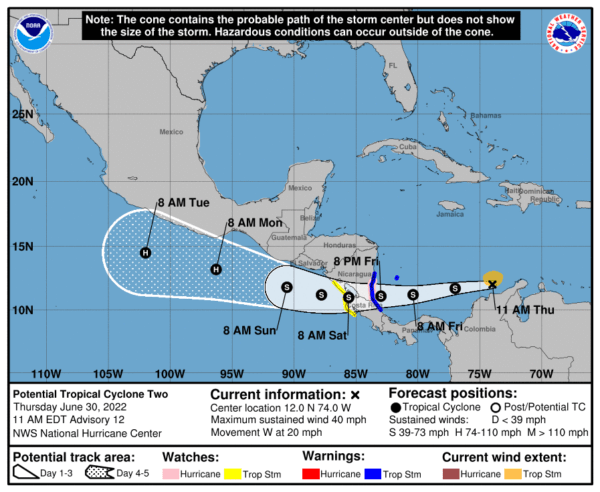Nicaragua Prepares for Tropical Storm Bonnie

According to the course predicted by the National Hurricane Center, the storm will cross the south of Nicaragua or the north of Costa Rica on Friday night.
HAVANA TIMES – The storm moving in the southwestern Caribbean Sea is expected to strengthen on its way to Nicaragua and Costa Rica until it becomes Tropical Storm Bonnie, most likely later on Thursday. It would be the second such weather system formed so far this year in the Atlantic basin. The National Hurricane Center (NHC) issued a hurricane and tropical storm watch for areas of Nicaragua and Costa Rica, respectively, on Wednesday.
In a bulletin issued at 06:00 a.m. (Nicaragua time), the NHC indicated that the system began its trajectory in the southern part of the Windward Islands and continued through the Caribbean near the coasts of Venezuela and Colombia. At 11 a.m. ET today the center was located at 660 miles (1065 kilometers) east of Bluefields, in the South Caribbean.
It currently packs maximum sustained winds of 40 miles per hour (65 km/h) and is moving swiftly at 20 miles per hour (31 km/h) in a westerly direction.
According to the forecast track, this Thursday it will move through the southwestern Caribbean Sea and will cross southern Nicaragua or northern Costa Rica on Friday night, emerging over the eastern Pacific Ocean on Saturday. From there it may strengthen until it reaches hurricane strength.
Once the alerts related to the Caribbean coasts of Venezuela and Colombia have been suspended, a hurricane watch remains in effect for an area that goes from the border between Nicaragua and Costa Rica north to Pearl Lagoon, likewise there is a tropical storm warning for the Colombian island of San Andres.
Pass through Central America
On the Atlantic Coast of Costa Rica there is a tropical storm watch from Limon north to Sandy Bay Sirpi, in Nicaragua.
Maximum winds are expected to strengthen between now and Friday as the system approaches Central America.
Sone weakening is expected as the system crosses Central America, but strengthening is expected on Saturday once it moves over the Pacific Ocean.
The probability of formation of a cyclone is 90%, both for the 48-hour forecast and the five-day forecast. Tropical storm force winds extend outward up to 80 miles (130 km).
The passage of the phenomenon is going to make itself felt in the north of Colombia and more intensely in Nicaragua and Costa Rica with rains, which could give rise to flash floods, strong winds, and storm surge.
The authorities of the institutions that make up the National System for Disaster Prevention, Mitigation and Attention (Sinapred) have reported, through Nicaraguan government media, that they have more than 300 shelters ready, in case it is necessary to carry out evacuations.
Army suspends sails
The storm surge could raise sea levels by up to three feet (0.9 meters) above normal tide levels along the immediate coast of Nicaragua near and north of where the center makes landfall.
The Nicaraguan Army, through the Navy, suspended this Wednesday boat traffic to and from the 11 most important ports of the country, due to the threat posed by the weather system. They noted “they will not issue departures to vessels destined for the open sea, fishing banks, coastal communities, islands or adjacent keys, until further notice.”
Navigation was suspended for the ports of Bluefields, Corn Island, El Bluff and Puerto Cabezas, located on the Caribbean coast (east), as well as the maritime terminals of Corinto, Potosí, Puerto Sandino and San Juan del Sur, in the Pacific (west-southwest), plus those found in the Great Lake of Nicaragua: Granada, Moyogalpa, and San Carlos.
In addition, they recommended that the vessels that are fishing “take all security measures, and if necessary, move to a safe port, to avoid regrettable events.”
So far in the current hurricane season in the Atlantic, which began on June 1 and, according to the meteorological services, is going to be more active than normal, there has only been one named storm, Alex, which formed on June 5 near the Yucatan Peninsula with the remnants of Hurricane Agatha, the first to form this year in the Pacific area. Alex caused rains in the Yucatan and western Cuba and southern Florida.





